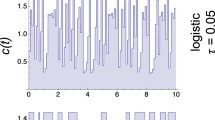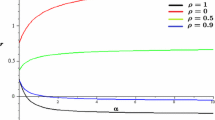Summary
The theory developed here applies to populations whose size x obeys a differential equation,
in which r and F are both periodic in t with period p. It is assumed that the function r, which measures a population's intrinsic rate of growth or intrinsic rate of adjustment to environmental change, is measurable and bounded with a positive lower bound. It is further assumed that the function F, which is determined by the density-dependent environmental influences on growth, is such that there is a closed interval J, with a positive lower bound, in which there lies, for each t, a number K(t) for which
and, as functions on J × ℝ, F is continuous, while ∂F/∂x is continuous, negative, and bounded. Because x(t) = 0, > 0, or < 0 in accord with whether K(t) = x(t), K(t) > x(t), or K(t) < x(t), the number K(t) is called the “carrying capacity of the environment at time t”. The assumptions about F imply that the number K(t) is unique for each t, depends continuously and periodically on t with period P, and hence attains its extrema, K min and K max. It is, moreover, easily shown that the differential equation for x has precisely one solution x * which has its values in J and is bounded for all t in ℝ; this solution is of period p, is asymptotically stable with all of J in its domain of attraction, and is such that its minimum and maximum values, x *min and x *max , obey
The following question is discussed: If the function F is given, and the function r can be chosen, which choices of r come close to maximizing, x *min ? The results obtained yield a procedure for constructing, for each F and each ɛ > 0, a function r such that x *min > K max − ɛ.
Similar content being viewed by others
References
Boyce, M. S., Daley, D. J.: Population tracking of fluctuating environments and natural selection for tracking ability. Am. Nat. 115, 480–491 (1980)
Coddington, E. A., Levinson, N.: Theory of ordinary differential equations. New York: McGraw-Hill 1955
Coffman, C. V., Coleman, B. D.: Oh the growth of populations with narrow spread in reproductive age: III. Periodic variations in the environment. J. Math. Biol. 7, 281–301 (1979)
Coleman, B. D.: Nonautonomous logistic equations as models of the adjustment of populations to environmental change. Math. Biosci. 45, 1–19 (1979)
Coleman, B. D., Hsieh, Y.-H.: Theory of the dependence of population levels on environmental history for semelparous species with short reproductive seasons. Proc. Nat. Acad, Sci. USA 76, 5407–5410 (1979)
Coleman, B. D., Hsieh, Y.-H., Knowles, G. P.: On the optimal choice of r for a population in a periodic environment. Math. Biosci. 46, 71–85 (1979)
Fretwell, S. D.: Populations in a seasonal environment. Princeton: Princeton University Press 1972
Goel, N. S., Richter-Dyn, N.: Stochastic models in biology. New York: Academic Press 1974
Hartman, P.: Ordinary differential equations. New York: Wiley 1964
Kiester, A. R., Barakat, R.: Exact solutions to certain stochastic differential equation models of population growth. Theoret. Population Biology 6, 199–216 (1974)
Kostitzin, V. A.: Sur la loi logistique et ses généralisations. Acta Biotheoret. 5, 155–159 (1940)
Levins, R.: The effect of random variations of different types on population growth. Proc. Nat. Acad. Sci. USA 72, 1061–1065 (1969)
May, R. M.: Stability and complexity in model ecosystems. Second edition. Princeton: Princeton University Press 1974
May, R. M.: Models for single populations. In: Theoretical ecology (R. M. May, ed.), pp. 4–25. Philadelphia: Saunders 1976
May, R. M.: Mathematical aspects of the dynamics of animal populations. In: Studies in Mathematical Biology. Part II (S. A. Levin, ed.), pp. 317–366. Providence: Mathematical Association of America 1978
Roughgarden, J.: A simple model for population dynamics in stochastic environments. Am. Nat. 109, 713–716 (1975)
Sánchez, D. A.: Periodic environments, harvesting, and a Riccati equation. In: Proc. Int. Conf. on Nonlinear Phenomena in Math. Sci., Arlington Texas. June 1980, in press
Sonneveld, P., van Kan, J.: On a conjecture about the periodic solution of the logistic equation, J. Math. Biology 8, 285–289 (1979)
Author information
Authors and Affiliations
Rights and permissions
About this article
Cite this article
Coleman, B.D. On optimal intrinsic growth rates for populations in periodically changing environments. J. Math. Biology 12, 343–354 (1981). https://doi.org/10.1007/BF00276921
Received:
Issue Date:
DOI: https://doi.org/10.1007/BF00276921




